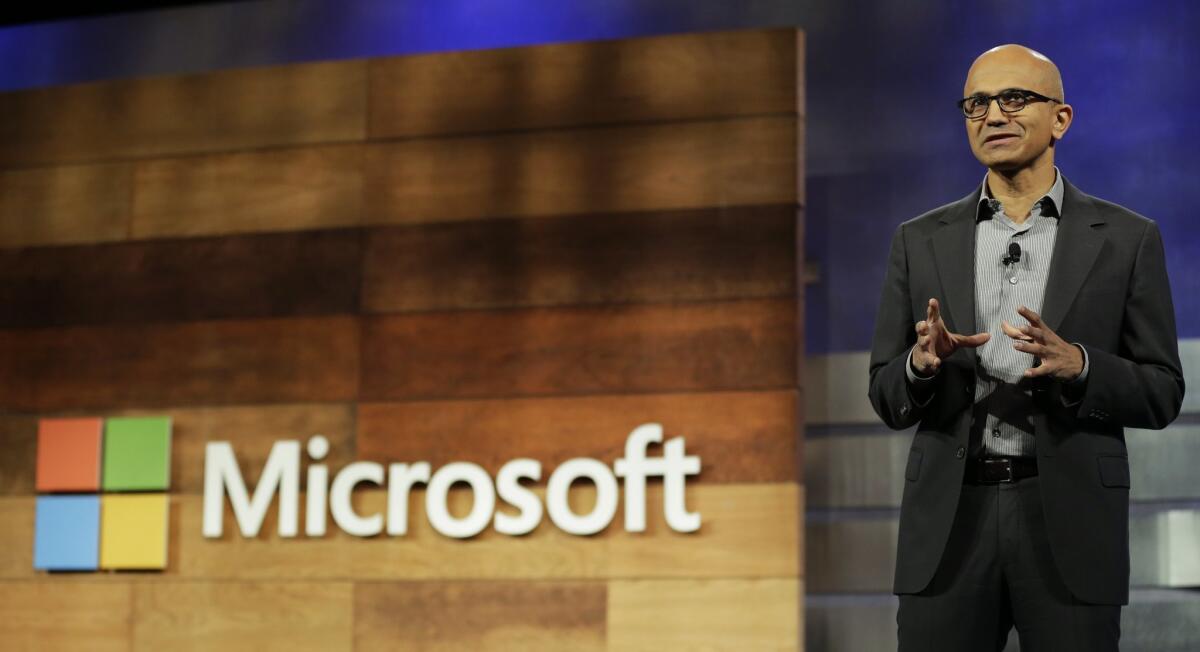Microsoft to invest $1 billion in carbon capture with pledge to go carbon-negative by 2030

- Share via
Microsoft Corp. unveiled plans to invest $1 billion to back companies and organizations working on technologies to remove or reduce carbon from the earth’s atmosphere, saying efforts to merely emit less carbon aren’t enough to prevent catastrophic climate change.
The company’s Climate Innovation Fund will provide money over the next four years for equity investments, debt financing and other support for the development of carbon-removal technology. The fund won’t be used for Microsoft’s philanthropic efforts on climate, although those will continue separately. The software maker is also pledging to be “carbon negative,” meaning it will remove more carbon than it emits, by 2030.
“This is the decade for urgent action for Microsoft and all of us,” Microsoft Chief Executive Satya Nadella said at an event Thursday at the company’s Redmond, Wash., campus.
Engineers have devised ways to capture carbon dioxide, either pulling it from the exhaust of smokestacks or sucking it directly from open air. The gas can be stored underground or put to use — for example, it can be incorporated into products such as cement. Because most governments don’t impose a penalty or tax for carbon emissions, there’s currently no monetary incentive for companies to buy the technologies, and developers have struggled to turn them into viable businesses. Most remain stuck at the demonstration stage, building showcase projects that illustrate what could be done, if someone were willing to pay for it. “A billion dollars is a lot and a little at the same time when you think about the investment level that’s probably going to be needed,” Microsoft President and Chief Legal Officer Brad Smith said Monday in a meeting with editors in New York previewing the event.
It’s not clear what efforts or companies Microsoft will back — it will now start to consider options for deploying the fund. But there are various ideas and efforts already under development. Switzerland’s Climeworks, for example, employs a reusable membrane to capture carbon dioxide pulled through machinery by fans. It then sells the concentrated gas, marketing it to beverage companies and plastic makers. Carbon Engineering, based in Canada, uses a chemical reaction to remove carbon dioxide directly from the air, with the gas either stored underground or used to make fuel.
As it cuts its emissions, Microsoft plans to tackle the amount of carbon it generates and the emissions released into the environment by suppliers and customers. The company said it will use 100% renewable energy for all its buildings and data centers by 2025, and electrify all campus vehicles by 2030. That’s part of Microsoft’s plan to be carbon negative in 10 years, meaning it will remove more carbon from the atmosphere than it emits. Two decades after that, the software maker said it will have removed from the environment all the carbon it has emitted either directly or by electrical consumption since its founding in 1975.
Some companies and local governments have been stepping up action on the environment, following the U.S. withdrawal from the Paris climate accord and amid rising concern about the pace of climate change. Companies such as Microsoft and Amazon.com Inc. are also under pressure from employees to do more, with Amazon facing vocal protests from a group called Amazon Employees for Climate Justice. In September, Amazon announced what it called the Climate Pledge, a commitment to meet the goals of the Paris agreement 10 years early, and invited other companies to sign on. Microsoft last year joined the Climate Leadership Council to advocate for a carbon tax. And on Jan. 14, BlackRock Inc. Chief Executive Larry Fink said climate change is “almost invariably the top issue that clients around the world raise with BlackRock.” Microsoft co-founder and board member Bill Gates is increasingly focusing on climate issues and plans a book on the topic later this year.
Microsoft and Amazon, along with other technology companies, have also been criticized for supplying software and cloud services to large oil and gas companies such as Chevron Corp. and BP Plc. BlackRock’s Fink has been trailed to work and public engagements by protesters decrying the investment firm for inaction on global warming and other issues.
Part of Microsoft’s announcement Thursday addresses the actions of customers, and the company will begin a plan to have clients and suppliers use Microsoft technology to reduce their own carbon footprints. Starting next year, Microsoft will make carbon reduction part of its procurement deals. The company is announcing an Azure Sustainability Calculator that lets cloud customers look at their own carbon output and shows the benefits of moving to the cloud from in-house server farms — a shift that could benefit Microsoft’s Azure business.
“Microsoft is at the helm of what could be a new movement towards negative emissions; it’s a big step beyond what most companies have committed to. But to really shift the needle on climate change, we need 1,000 other Microsofts to follow suit and turn rhetoric into action,” the Environmental Defense Fund said in a statement.
The company said it intends to take action on several types of emissions, including direct and electrical and heat use, but also the indirect carbon emissions that come from things such as manufacturing, materials in its buildings and the electricity consumers use when deploying Microsoft products. At Microsoft, that indirect category is about three times the others combined. While the company said it has been “carbon neutral” since 2012, “our recent work has led us to conclude that this is an area where we’re far better served by humility than pride. And we believe this is true not only for ourselves, but for every business and organization on the planet,” Smith wrote in a blog post announcing the plans.
Microsoft accomplished carbon neutrality, like most companies, by reducing and avoiding emissions, Smith said, but that’s no longer enough.
“We will not solve this problem by doing nothing,” Smith said.
David R. Baker and Max Chafkin contributed to this report.






